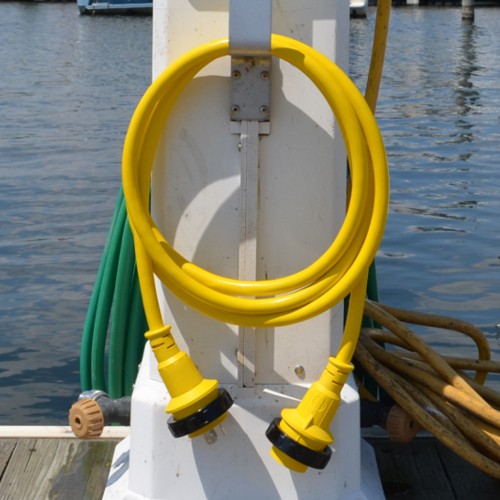Ship to Shore Power
The connection of 230V – 240V AC power from the ship to the shore is made by a shore power lead or cord. Needless to say, connecting potentially lethal AC power from land to a boat in the water, with the cord often running across jetties or pontoons with heavy foot and vehicle traffic, all adds up to a situation that can be very dangerous.
It is therefore imperative that the proper equipment be carefully selected and that this should be maintained in good working order at all times. Care must also be taken when using the connection to route the cord in a way that will prevent it being damaged.
Most Australian marinas provide shore power from an outlet rated 240VAC 15A. They should have power outlets with the three pin, Y-configuration as per Australian standards. The 15A connections have a wider earth pin than the 10A connections very commonly found in most Australian households. This ensures that a load that will potentially draw up to 15A can only be connected to an outlet that is suited to supply that current.
Most marinas have IP66 rated (waterproof) outlets. These have a male thread moulded into the housing around the outlet. The IP66 rated, 240V15A plugs that fit into them have a matching collar that screws onto the outlet once it’s plugged in, thus ensuring a waterproof connection and preventing the plug from being disconnected unintentionally if the cord is pulled on for whatever reason.
Your boat is regarded as an appliance
The cable used for the shore power cord should have a cross sectional area of at least 2.5mm². As this cable will be used in a marine environment, it should be tinned to prevent corrosion. It must have heavy duty insulation that can withstand marina traffic, boats chaffing against it as well as fuels, oils and chemicals. We so often find customers asking why they cannot just use the builders’ extension leads that are available from hardware shops? Those have light duty insulation, are untinned and often only have a cross sectional area of 1.5mm². Buying cheap is definitely false economy!
The appliance is fitted with a plug, the supply lead with a socket. This ensures that if the unplugged lead is live, there are no exposed terminals that could pose a danger. While the boat could be fitted with a hardwired lead with an inline plug at the end of it like any other appliance, it is more common to use an appliance inlet that is fixed to the boat onto which the outlet on the shore power cord is fitted.
Contact Sydney Marine Electrical for your Shore Power needs. We are fully licenced and have extensive knowledge of Sydney’s marinas and their Shore Power setups.
For more information or to request a quote please complete our REQUEST FORM. For general inquiries please use our CONTACT FORM.
Written by by Kurt Küpper from Afloat.


